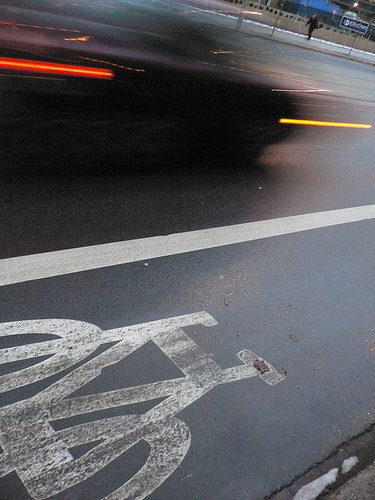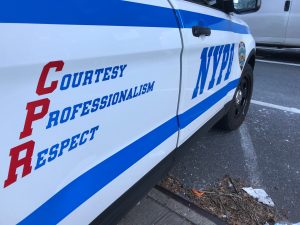Report: Tame Traffic, and More People Will Choose to Walk and Bike
 Research shows that more traffic means fewer cyclists. Photo by jaygoldman via Flickr.
Research shows that more traffic means fewer cyclists. Photo by jaygoldman via Flickr.It may seem obvious that speeding traffic discourages walking and biking. But the evidence is scarce and scattered. A new paper by Peter Jacobsen, Francesca Racioppi and Harry Rutter aims to improve the understanding of how traffic affects cyclist and pedestrian behavior by collecting the existing research in one place.
"Who Owns the Roads? How Motorised Traffic Discourages Walking and Bicycling" adds some empirical weight to the intuition that traffic enforcement is one of the biggest missing ingredients in New York City’s push for healthier, more livable streets. "This article states the obvious perhaps — that motorized traffic discourages walking and bicycling, and hence impacts health,” said lead author Jacobsen, a public health consultant who also wrote the influential "Safety in Numbers" report.
For example, while improvements in pedestrian infrastructure increase walking — one study cited in "Who Owns the Roads?" found that four times as many people walk along streets with sidewalks compared to those without — what happens on the street itself matters as well. The same study reported that more than six times as many people walk along streets with only two lanes as walk along four-lane roads.
This research should ring true to New Yorkers. The city — compact, flat, with well-connected street grids — is in many ways perfectly suited for cycling. Even so, the 2008 Census shows that of the 60 largest U.S. cities, New York ranks 32nd in the percentage of commuters who get to work on a bike.
Jacobsen’s research suggests that New York not only needs bike lanes and safer sidewalks, it also needs to reduce congestion and tame its lawless traffic. In China, he notes, bicycling has declined as car use has risen — not so much because cyclists are driving more, but mainly because they perceive greater danger on the street. Perceptions of danger influence New Yorkers too. Surveys conducted for Transportation Alternatives’ 2009 report, "From Chaos to Compliance" [PDF], found that 43 percent of pedestrians avoid specific locations due to fear of motorists flouting traffic laws.
“Who Owns the Roads?” proposes lower speed limits, congestion pricing and traffic calming as critical aspects of creating a bike- and pedestrian-friendly city. It also implies that in New York, where nearly 40 percent of motorists exceed the speed limit, each of these policies would prove much more effective if accompanied by effective enforcement of traffic laws. Whether through cameras or cops, the city won’t become friendly to cyclists and pedestrians if laws exist on the books but not on the street.
